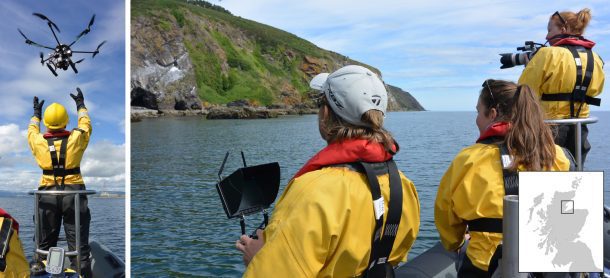
UAS photogrammetry surveys from a small RIB using a LexHex-44 hexacopter, including manual hand launch and recovery, operation approximately 30‰meters above a group of bottlenose dolphins with a first-person viewscreen for the operator and concurrent photo-identification and laser photogrammetry. Inset map of the study area, the Moray Firth Special Area of Conservation, Scotland. (Credit: Remote Sensing in Ecology and Conservation)
Researchers have found a way to remotely determine if protected female bottlenose dolphins are expecting a calf using aerial photos taken from drones. By measuring the body width of the cetaceans captured in the aerial images, the scientists can establish which females in the group are pregnant.
The study, from University of Aberdeen researchers based at the Lighthouse Field Station, Cromarty, in collaboration with Duke University and their Marine Robotics and Remote Sensing Laboratory (MaRRS), is the first to non-invasively establish whether the female bottlenose dolphins are pregnant.
Published in Remote Sensing in Ecology and Conservation, the study shows that researchers can gather data on failed pregnancies which could provide information on an individual's health and help identify the causes of changes in the population, for example due to lack of food.
Scientists from the University have been monitoring the bottlenose dolphin population that uses the Moray Firth Special Area of Conservation for more than 30 years.
For this study, the researchers compared the aerial images to information from this long-term study including whether the females had had a calf and their age.

